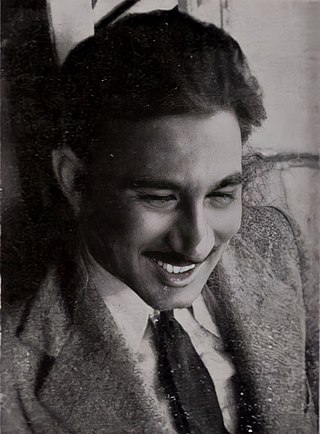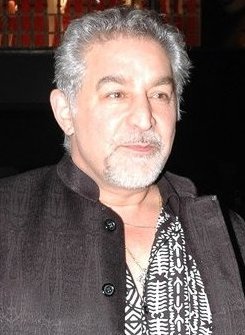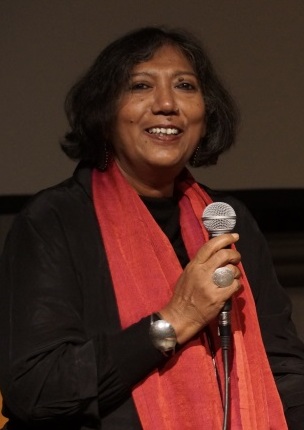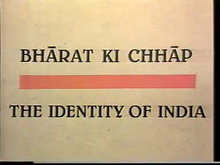
Khwaja Ahmad Abbas was an Indian film director, screenwriter, novelist, and journalist in Urdu, Hindi and English. He won four National Film Awards in India. Internationally, his films won the Palme d'Or at Cannes Film Festival and the Crystal Globe at Karlovy Vary International Film Festival. As a director and screenwriter, he is considered one of the pioneers of Indian parallel or neo-realistic cinema.

Bharatbhushan Gupta, better known as Bharat Bhushan was an Indian actor in Hindi language films, scriptwriter and producer, who is best remembered for playing Baiju Bawra in the 1952 film of the same name. He was born in Meerut, and brought up in Aligarh, Uttar Pradesh.

Bharat Ek Khoj is a 53-episode Indian historical drama based on the book The Discovery of India (1946) by Jawaharlal Nehru that covers a 5,000-year history of India from its beginnings to independence from the British in 1947. The drama was directed, written and produced by Shyam Benegal with cinematographer V. K. Murthy in 1988 for state-owned Doordarshan. Shama Zaidi co-wrote the script. Its cast included Om Puri, Roshan Seth, Tom Alter and Sadashiv Amrapurkar. Jawaharlal Nehru was portrayed by Roshan Seth, the same role he portrayed in the film Gandhi.

Chintamani Nagesa Ramachandra Rao,, is an Indian chemist who has worked mainly in solid-state and structural chemistry. He has honorary doctorates from 84 universities from around the world and has authored around 1,800 research publications and 56 books. He is described as a scientist who had won all possible awards in his field except the Nobel Prize.
Indian television dramas are dramatic television programs written, produced, and filmed in India, with characters played by Indian actors and episodes broadcast on Indian televisions.

Dalip Tahil is an Indian film, television and theatre actor. He is best known for his work in Baazigar (1993), Raja (1995), Hum hai rahi pyar ke (1993) and Qayamat Se Qayamat Tak (1988), Pyaar Ki Miss Call (2009) along with actor Gaurav Prateek. In the UK, he appeared in the BBC soap opera EastEnders as Dan Ferreira, the head of the Ferreira family, from June to December 2003.

Manoj N. Joshi is an Indian actor known for working in film, stage television. He has also acted in over 70 films since 1998, many of his roles being comedy. He is the recipient of several awards including a National Film Award. Joshi is popularly known for playing Kachra Seth in Phir Hera Pheri (2006).

Chanakya is a 47-part drama epic Indian television historical drama written and directed by Dr. Chandraprakash Dwivedi that was originally telecasted on DD National from 8 September 1991 to 9 August 1992. Produced by Prakash Dwivedi, the series is a fictionalized account of the life and times of 4th century BCE Indian economist, strategist and political theorist Chanakya and is based on events occurring between 340 BCE and 321/20 BCE, starting with Chanakya's boyhood and culminating in the coronation of Chandragupta Maurya. Chandraprakash Dwivedi played the title role of Chanakya.

Karan Grover is an Indian actor who primarily works in Hindi television. He made his acting debut in 2004 with Saarrthi as Arjun Goenka. Grover is best known for his portrayal of Karan Prasad in Yahan Main Ghar Ghar Kheli, Dr. Rohit Sippy in Kahaan Hum Kahaan Tum and Angad Maan in Udaariyaan.

Vanraj Bhatia was an Indian composer best known for his work in Indian New Wave cinema. He was also one of the leading composers of Western classical music in India.

Rajendra Gupta is an Indian film, television and theatre actor and director who is known for his television roles of Adina Beg Khan Sahib e Azam in 2010 series of Maharaja Ranjit Singh, Pandit Jagannath in the 1990s Doordarshan fantasy television series Chandrakanta and Sudha's father – Jagat Narayan – in the 1998–2001 Sony TV drama Saaya.

Surendrapal Singh is an Indian film and television character actor who works in Hindi films and TV series. He is best known for his roles of Dronacharya in Mahabharat, Amatya Rakshas in Chanakya, Tamraj Kilvish in Shaktiman and Daksha in Devon Ke Dev...Mahadev.

Bible Ki Kahaniyan is an Indian Hindi-language television program based upon scriptures from the Bible. The production aspired to complete both Old Testament and New Testament narratives of the Bible but was later discontinued after covering the Patriarch narrative in the Book of Genesis. It was produced by Appachan through his Navodaya Studio and was broadcast on DD National from 1992 to mid 1993 and again, concluding with the remaining episodes, in 1996.

Ramadas Panemangalore Shenoy was an Indian defence scientist and writer, known for his contributions in the field of radar technology. He secured a doctoral degree in electrical engineering from the University of Wisconsin–Madison and joined Defence Research and Development Organization in 1961, involving himself with the indigenous development of radar technology till his retirement, as a Distinguished Scientist, in 1989.
Riya Deepsi is an Indian film and television actress and model. She debuted in 2013 with the television series Mahabharat. In 2018, she made her Hindi film debut with Bhaagte Raho.

Madhusree Dutta is an Indian filmmaker, author and curator.
Shantaram is an American-Australian drama thriller television series created by Eric Warren Singer and Steve Lightfoot, based on the novel of the same name by Gregory David Roberts. The story drew inspiration from Roberts' own life, which is about a bank robber from Australia who flees the country to India. The series consists of twelve episodes directed by Bharat Nalluri, Iain B. MacDonald and Bronwen Hughes. Steve Lightfoot joined as showrunner after Eric Warren Singer departed the project. It is produced by Fair Honest Positive Creative, The 4 Keys, Bohemian Risk Productions, Square Head Productions, Anonymous Content and Paramount Television Studios and was distributed by Apple Inc. for their streaming service, Apple TV+. The series premiered on 14 October 2022 and concluded on 16 December 2022. In December 2022, the series was cancelled after one season.
Chandita Mukherjee was an Indian documentary filmmaker, science communicator and activist. She was the recipient of two National Film Awards. She conceived and directed the TV series Bharat Ki Chhap on the history of science and technology in India. She was the Executive Director of Comet Media Foundation.














